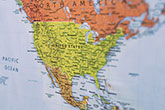White space exploration opportunities, Part 3
Published by David Bizley,
Editor
Oilfield Technology,
William M. Brown, Metric Systems Corp., explores the opportunities provided by the use of the white space spectrum in the Marcellus Shale region.
Deploying the network and building a band plan
Today each of these pads is in the production stage. For now, assume that a multi-well development process, which will require a suite of voice, data and video services as well site development progresses, is commencing. Table 3 presents a payload bandwidth estimation required to sustain multiple plays in various stages of development. Our goal here is to show that when infrastructure White Space wireless systems are integrated into a normal suite of third-party communications services, i.e. satellite, common carrier (4G/LTE), point-to-point microwave and fibre, the white space advantage will allow uniform sharing of bandwidth and services between multiple locations in a more efficiently and fiscally-effective manner.
.jpg)
Completing the physical design of the network we will need to determine which TV channels are available at each pad. This can be done by accessing one of several FCC-certified data bases. The Telcordia database previously cited is used to determine available channels at each pad entering co-ordinates, the Telcordia data base will return available channels, normally at the zip code centre of the target county. See Table 4 (below) for available channels at pad 1. Figure 1 (available here) summarises the deployment concept of broadband mesh network interconnection in five pad sites over a 222 square mile area. As a rule of thumb, the lower channels were chosen for challenging near and non line-of-sight critical paths; higher UHF channels for clear line-of-sight and/or tree level paths.
.jpg)
Wide area long distance cover
White space spectrum also provides superior reach out in point-to-multipoint applications. For servicing multiple locations from a common central point, e.g. WiFi range extension, SCADA and VoIP and video. Figure 5 is a montage of WiFi unlicensed radial spectrum coverage of the example play area from low band VHF to 5.8 GHz. The wide-area coverage provided by the VHF low and high band provides superior coverage over 900 MHz, 2.4 and 5.8 GHz systems allowing reach out to lowlands and terrain depressions, covering greater range and terrain variations.

Figure 5. A sequential montage showing the superior coverage of white space bands over a 12.4 mile (20 km) 80% forested area. Yellow dot is centre of production area. Base Station antenna height is 60 ft. Remote site height 15 ft. Total area coverage 22.4 x 10 miles (36 x 16 km). 2.4 GHz plot shows 7 miles (11.3 km) coverage radius.
White space equipment availability and operation
Several companies have launched and are planning to introduce certified white space equipment in the 2013 to 2014 period.
Carlson Wireless Technologies, Inc., Arcata, CA, has already introduced the Rural Connect, a UHF only system.
Metric Systems Corporation, Vista, CA will soon introduce its RaptorX, aimed towards industrial and enterprise users in the US and abroad. The RaptorX will support operation in all US and proposed Canadian white space bands.
Tessco Technologies, Reno, NV, has partnered with KTS Wireless (KTSW), a developer of low-frequency data radio products, to distribute the Agility White Space Radio (AWR) in North America.
Summary
The additional availability of nearly 300 MHz of unlicensed spectrum and equipment will provide every sector of the energy industry, in general, and the oil and gas sectors specifically, with the resources to enhance the security and operational effectiveness of each link of the production chain. In addition, low cost, high resolution, wide-area sensor coverage, and wide-area environmental coverage will provide a quantitative basis to address uncertainty in watershed monitoring.
Part 1 of this article can be reached here.
Part 2 of this article can be reached here.
Adapted by David Bizley
Read the article online at: https://www.oilfieldtechnology.com/exploration/25112013/space_exploration_part_3/
You might also like
TGS secures new OBN data acquisition contract in North America
This six-month-plus contract, granted by a returning client, underscores TGS' commitment to delivering high quality seismic data solutions.

